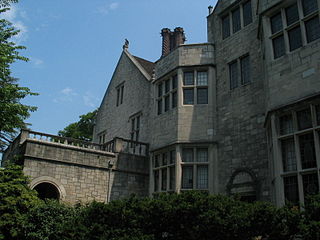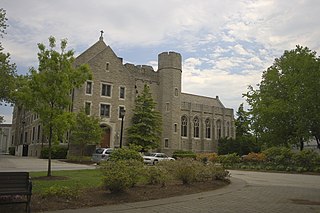
The Arnold Arboretum of Harvard University is a botanical research institution and free public park, located in the Jamaica Plain and Roslindale neighborhoods of Boston, Massachusetts. Established in 1872, it is the oldest public arboretum in North America. The landscape was designed by Charles Sprague Sargent and Frederick Law Olmsted and is the second largest "link" in the Emerald Necklace. The Arnold Arboretum's collection of temperate trees, shrubs, and vines has a particular emphasis on the plants of the eastern United States and eastern Asia, where arboretum staff and colleagues are actively sourcing new material on plant collecting expeditions. The arboretum supports research in its landscape and in its Weld Hill Research Building.
The R. A. Stranahan Arboretum 47 acres is located at 4131 Tantara Drive, Toledo, Ohio, about a 10-minute drive from the main campus of the University of Toledo. It contains 1,500 specimens of cultivated, mature trees from China, Serbia, Japan, and Norway, as well as North American varieties ranging from Bristlecone Pine to Buckeye.

The Iowa Arboretum is a nonprofit arboretum located in Madrid, Iowa that encompasses 160 acres (65 ha). The grounds are open daily from sunrise to sunset.

The Bertrand F. Harrison Arboretum, also known as the Brigham Young University Arboretum, is an arboretum located on a hill beside at 800 North Street on the campus of Brigham Young University in Provo, Utah, United States. It includes a native plants from both eastern and western regions of the United States. It also has a duck pond and a stream, as well as a brick path that winds through the garden.

Peace Park also known as McAlester Arboretum is a park and arboretum located on the University of Missouri campus in Columbia, Missouri, United States. It was renamed Peace Park after the Kent State Massacre, to which there is a memorial in the park. The park is near Francis Quadrangle and the Missouri School of Journalism. Across Elm Street is Downtown Columbia and the Columbia Missourian, Shakespeare's Pizza, and the State Historical Society of Missouri. Peace Park is popular with students, faculty, and Columbia residents alike.
The State Arboretum of Utah is an arboretum located across the campus of the University of Utah in Salt Lake City, Utah, as well as on an additional site at Red Butte Garden and Arboretum. The campus grounds and the Red Butte Garden are open to the public every day. The conservatory is open by appointment only.

Planting Fields Arboretum State Historic Park, which includes the Coe Hall Historic House Museum, is an arboretum and state park covering over 400 acres (160 ha) located in the village of Upper Brookville in the town of Oyster Bay, New York.

The Stanford University Arboretum is an arboretum located on the grounds of Stanford University in Stanford, California. It is open to the public daily without charge.

The Colonial Park Arboretum and Gardens are gardens and an arboretum located in Colonial Park, 150 Mettlers Road, in the East Millstone area of Franklin Township, in Somerset County, New Jersey. The grounds are open daily without fee.

Arboretum Villanova is the name of a former 222-acre arboretum located throughout the campus of Villanova University in Villanova, Pennsylvania. It is open to the public daily without charge.

Secrest Arboretum is an arboretum located on the campus of the Ohio Agricultural Research and Development Center (OARDC), at the intersection of Pine Road and Green Drive, Wooster, Ohio. It is open daily without charge and hosts an estimated 10,000 visitors each year.

Chadwick Arboretum is a 62 acres (25 ha) arboretum on the Agriculture campus of The Ohio State University, in Columbus, Ohio, United States. The main arboretum collection is located just across Lane Avenue from the Schottenstein Center with its other collections nearby. The arboretum is open daily without charge.
Liberty Forge Arboretum is an arboretum on the grounds of a commercial golf course, located at 3804 Lisburn Road, Mechanicsburg, Pennsylvania.
Davidson College Arboretum is located on Davidson College's 600-acre campus in Davidson, North Carolina. The campus was designated a national arboretum in 1986, but the origins of the arboretum stretch to 1855, when “a few ladies of Davidson College” proposed landscape remodeling to the Board of Trustees. Students organized tree plantings in 1861; then in 1869, the faculty sent a proposal to the Board of Trustees recommending that the campus "represent in time the forest growth of the State, and if possible, the general botany of the region."

Ulmus macrocarpaHance, the large-fruited elm, is a deciduous tree or large shrub endemic to the Far East excluding Japan. It is notable for its tolerance of drought and extreme cold and is the predominant vegetation on the dunes of the Khorchin sandy lands in the Jilin province of north-eastern China, making a small tree at the base of the dunes, and a shrub at the top.

The Field Elm cultivar Ulmus minor 'Webbiana', or Webb's curly-leaf elm, distinguished by its unusual leaves that fold upwards longitudinally, was said to have been raised at Lee's Nursery, Hammersmith, London, circa 1868, and was first described in that year in The Gardener's Chronicle and The Florist and Pomologist. It was marketed by the Späth nursery of Berlin in the late 19th and early 20th centuries as U. campestris WebbianaHort., and by Louis van Houtte of Ghent as U. campestris crispa (Webbiana). Henry thought 'Webbiana' a form of Cornish Elm, adding that it "seems to be identical with the insufficiently described U. campestris var. concavaefoliaLoudon" – a view repeated by Krüssmann.
The Siberian Elm cultivar Ulmus pumila 'Pyramidalis Fiorei' was cloned by the Charles Fiorei Nurseries of Prairie View, Illinois, c. 1957 from a tree growing in nursery grounds.
The elm cultivar Ulmus 'Myrtifolia', the Myrtle-leaved Elm, first appeared in nursery and horticultural lists from the 1830s, as Ulmus myrtifolia and Ulmus campestris myrtifolia, the name Ulmus myrtifoliaVolxem being used at Kew Gardens from 1880. Lawson's nursery of Edinburgh appears to have been the earliest to list the tree. 'Myrtifolia' was listed by Nicholson in Kew Hand-List Trees & Shrubs (1896), but without description. It was later listed as a cultivar and described by Rehder in 1939 and by Krüssmann in 1962.

The Siberian elm cultivar Ulmus pumila 'Pinnato-ramosa' was raised by Georg Dieck, as Ulmus pinnato-ramosa, at the National Arboretum, Zöschen, Germany, from seed collected for him circa 1890 in the Ili valley, Turkestan by the lawyer and amateur naturalist Vladislav E. Niedzwiecki while in exile there. Litvinov (1908) treated it as a variety of Siberian elm, U. pumilavar.arborea but this taxon was ultimately rejected by Green, who sank the tree as a cultivar: "in modern terms, it does not warrant recognition at this rank but is a variant of U. pumila maintained and known only in cultivation, and therefore best treated as a cultivar". Herbarium specimens confirm that trees in cultivation in the 20th century as U. pumilaL. var. arboreaLitv. were no different from 'Pinnato-ramosa'.
Tanger is the French spelling of Tangier, sometimes called Tangiers, a city in Morocco.













